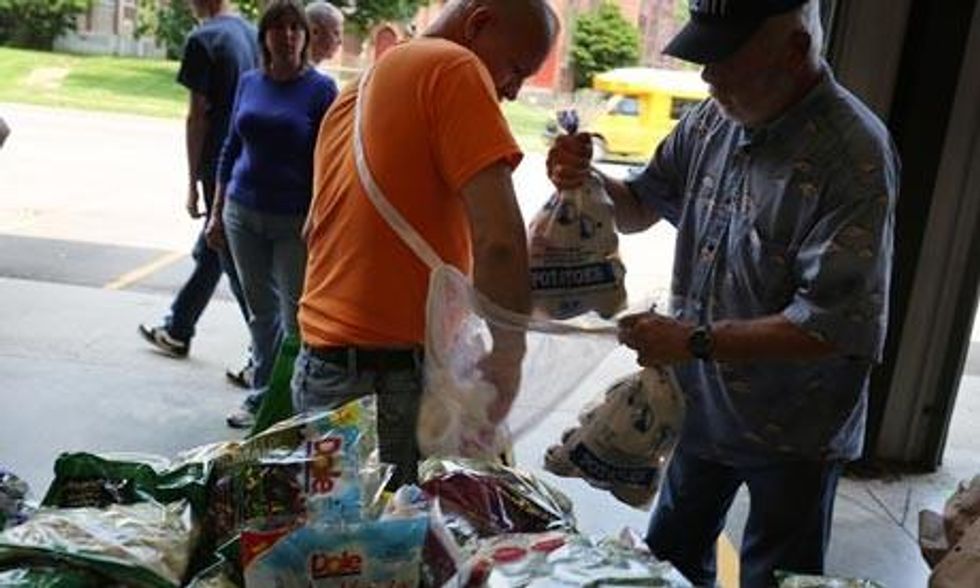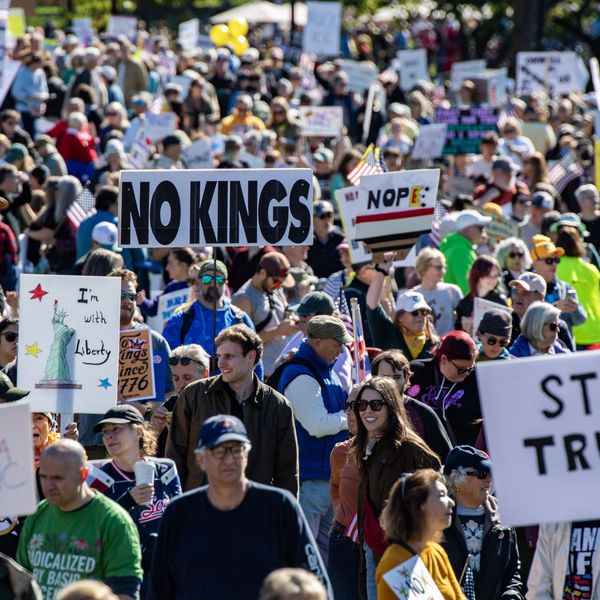Record Poverty Persists While Gap Between Rich and Rest of Us Increases
Sadly, those who "occupied" Wall Street and city squares across the country in 2011, were right: All of the income gains have concentrated at the top, while the rest of us saw a deterioration or stagnation in our wages and income.

We can't seem to stop having record numbers of people living in poverty in the United States. The richest continue to get richer and the rest of us continue to see our incomes get lower and lower.
New Census Bureau figures released Wednesday, show that 15 percent of the U.S. population lived in poverty in 2011. Over 46 million Americans lived at or below the poverty threshold of a household income of $23,201 per year for a family of four. One in five of our children live in poverty and over one-third of black and Latino children are struggling through impoverishment.
In 2011, we saw the first one-year increase in income inequality [L1] since 1993. The top 5% gained 5.3% in income in 2011 over 2010. The lowest quintile saw little change, but the second-lowest, middle, and fourth-lowest quintiles all experienced a decline in income over the year. Sadly, those who "occupied" Wall Street and city squares across the country in 2011, were right: All of the income gains have concentrated at the top, while the rest of us saw a deterioration or stagnation in our wages and income.
This data also confirms that safety programs work. According to the Census Bureau, unemployment benefits kept 2.3 million of us out of poverty in 2011, Social Security benefits kept over 21 million people out of poverty and, if we count the nutrition aid of the Food Stamps program as income, it would show that 3.9 million people were lifted above the poverty line in 2011.
Increasingly, all of the boost in wealth is concentrated at the top and record numbers of poverty persist, while the middle and lower-economic classes are losing ground. Now is not the time to lower taxes on the wealthiest by cutting proven, effective anti-poverty measures such as Unemployment Insurance, Supplemental Nutrition Assistance, the Earned Income Tax Credit, Social Security, and new coverage benefits gained from the health care reform law.
The rich shouldn't be rewarded while the rest of struggle.
An Urgent Message From Our Co-Founder
Dear Common Dreams reader, The U.S. is on a fast track to authoritarianism like nothing I've ever seen. Meanwhile, corporate news outlets are utterly capitulating to Trump, twisting their coverage to avoid drawing his ire while lining up to stuff cash in his pockets. That's why I believe that Common Dreams is doing the best and most consequential reporting that we've ever done. Our small but mighty team is a progressive reporting powerhouse, covering the news every day that the corporate media never will. Our mission has always been simple: To inform. To inspire. And to ignite change for the common good. Now here's the key piece that I want all our readers to understand: None of this would be possible without your financial support. That's not just some fundraising cliche. It's the absolute and literal truth. We don't accept corporate advertising and never will. We don't have a paywall because we don't think people should be blocked from critical news based on their ability to pay. Everything we do is funded by the donations of readers like you. Will you donate now to help power the nonprofit, independent reporting of Common Dreams? Thank you for being a vital member of our community. Together, we can keep independent journalism alive when it’s needed most. - Craig Brown, Co-founder |
Sadly, those who "occupied" Wall Street and city squares across the country in 2011, were right: All of the income gains have concentrated at the top, while the rest of us saw a deterioration or stagnation in our wages and income.

We can't seem to stop having record numbers of people living in poverty in the United States. The richest continue to get richer and the rest of us continue to see our incomes get lower and lower.
New Census Bureau figures released Wednesday, show that 15 percent of the U.S. population lived in poverty in 2011. Over 46 million Americans lived at or below the poverty threshold of a household income of $23,201 per year for a family of four. One in five of our children live in poverty and over one-third of black and Latino children are struggling through impoverishment.
In 2011, we saw the first one-year increase in income inequality [L1] since 1993. The top 5% gained 5.3% in income in 2011 over 2010. The lowest quintile saw little change, but the second-lowest, middle, and fourth-lowest quintiles all experienced a decline in income over the year. Sadly, those who "occupied" Wall Street and city squares across the country in 2011, were right: All of the income gains have concentrated at the top, while the rest of us saw a deterioration or stagnation in our wages and income.
This data also confirms that safety programs work. According to the Census Bureau, unemployment benefits kept 2.3 million of us out of poverty in 2011, Social Security benefits kept over 21 million people out of poverty and, if we count the nutrition aid of the Food Stamps program as income, it would show that 3.9 million people were lifted above the poverty line in 2011.
Increasingly, all of the boost in wealth is concentrated at the top and record numbers of poverty persist, while the middle and lower-economic classes are losing ground. Now is not the time to lower taxes on the wealthiest by cutting proven, effective anti-poverty measures such as Unemployment Insurance, Supplemental Nutrition Assistance, the Earned Income Tax Credit, Social Security, and new coverage benefits gained from the health care reform law.
The rich shouldn't be rewarded while the rest of struggle.
Sadly, those who "occupied" Wall Street and city squares across the country in 2011, were right: All of the income gains have concentrated at the top, while the rest of us saw a deterioration or stagnation in our wages and income.

We can't seem to stop having record numbers of people living in poverty in the United States. The richest continue to get richer and the rest of us continue to see our incomes get lower and lower.
New Census Bureau figures released Wednesday, show that 15 percent of the U.S. population lived in poverty in 2011. Over 46 million Americans lived at or below the poverty threshold of a household income of $23,201 per year for a family of four. One in five of our children live in poverty and over one-third of black and Latino children are struggling through impoverishment.
In 2011, we saw the first one-year increase in income inequality [L1] since 1993. The top 5% gained 5.3% in income in 2011 over 2010. The lowest quintile saw little change, but the second-lowest, middle, and fourth-lowest quintiles all experienced a decline in income over the year. Sadly, those who "occupied" Wall Street and city squares across the country in 2011, were right: All of the income gains have concentrated at the top, while the rest of us saw a deterioration or stagnation in our wages and income.
This data also confirms that safety programs work. According to the Census Bureau, unemployment benefits kept 2.3 million of us out of poverty in 2011, Social Security benefits kept over 21 million people out of poverty and, if we count the nutrition aid of the Food Stamps program as income, it would show that 3.9 million people were lifted above the poverty line in 2011.
Increasingly, all of the boost in wealth is concentrated at the top and record numbers of poverty persist, while the middle and lower-economic classes are losing ground. Now is not the time to lower taxes on the wealthiest by cutting proven, effective anti-poverty measures such as Unemployment Insurance, Supplemental Nutrition Assistance, the Earned Income Tax Credit, Social Security, and new coverage benefits gained from the health care reform law.
The rich shouldn't be rewarded while the rest of struggle.

